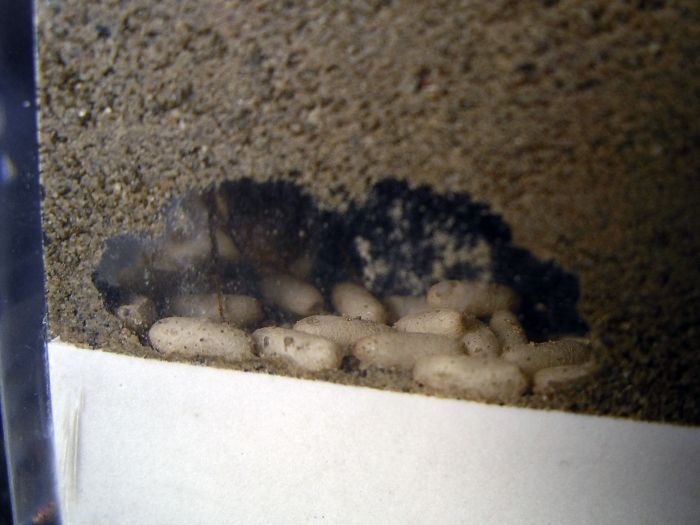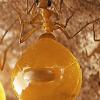- Formiculture.com
- Forums
- Gallery
- Members
- Member Map
- Chat

Dspdrew's Myrmecocystus mexicanus Journal [124] (Updated 2-4-2024)
Started By
dspdrew
, Nov 14 2013 11:12 AM
myrmecocystus dspdrew journal
245 replies to this topic
#61
![Dspdrew's Myrmecocystus mexicanus Journal [124] (Updated 2-4-2024): post #61](https://www.formiculture.com/public/style_images/shivana/icon_share.png) Offline
-
Posted July 11 2015 - 3:20 PM
Offline
-
Posted July 11 2015 - 3:20 PM
Those queens look amazing. So jealous. I love yellow ants.
- BugFinder likes this
#62
![Dspdrew's Myrmecocystus mexicanus Journal [124] (Updated 2-4-2024): post #62](https://www.formiculture.com/public/style_images/shivana/icon_share.png) Offline
-
Posted July 12 2015 - 10:00 AM
Offline
-
Posted July 12 2015 - 10:00 AM
Are you experimenting with any founding setups other than test tube and ant box?
Camponotus vicinus, Crematogaster 1, Crematogaster 2, Formica francoeuri, *, *, Myrmecocystus testaceus, Novomessor cockerelli, Pheidole hyatti, Pogonomyrmex californicus, Pogonomyrmex rugosus, Solenopsis invicta
#63
![Dspdrew's Myrmecocystus mexicanus Journal [124] (Updated 2-4-2024): post #63](https://www.formiculture.com/public/style_images/shivana/icon_share.png) Offline
-
Posted July 12 2015 - 1:34 PM
Offline
-
Posted July 12 2015 - 1:34 PM
I have them in test tubes, dirt boxes, and in my little prototype test tube replacement formicarium.
- BugFinder likes this
#64
![Dspdrew's Myrmecocystus mexicanus Journal [124] (Updated 2-4-2024): post #64](https://www.formiculture.com/public/style_images/shivana/icon_share.png) Offline
-
Posted July 12 2015 - 4:48 PM
Offline
-
Posted July 12 2015 - 4:48 PM
Do you think the flew in the High Desert area around Palmdale, El Mirage, and Phelan too? Awesome catch by the way.
#65
![Dspdrew's Myrmecocystus mexicanus Journal [124] (Updated 2-4-2024): post #65](https://www.formiculture.com/public/style_images/shivana/icon_share.png) Offline
-
Posted July 12 2015 - 11:30 PM
Offline
-
Posted July 12 2015 - 11:30 PM
It's possible. It rained a little bit in some of those places, but I don't know if there was enough.
#66
![Dspdrew's Myrmecocystus mexicanus Journal [124] (Updated 2-4-2024): post #66](https://www.formiculture.com/public/style_images/shivana/icon_share.png) Offline
-
Posted July 17 2015 - 5:50 AM
Offline
-
Posted July 17 2015 - 5:50 AM
Update 7-17-2015
I put four more of these in my little ant farm boxes. Getting their eggs to them was not easy. I failed with one of them and ended up destroying its nest, so I tried something different. I put another hole in the container like the bottom one at the surface of the dirt and taped a very short test tube to it with the eggs inside. I figure this will give her a place to keep the eggs until she is done digging her chamber. With smaller queens, I just give them their eggs, and they find a place to put them while they dig, but these queens are so large they will probably end up burying them.
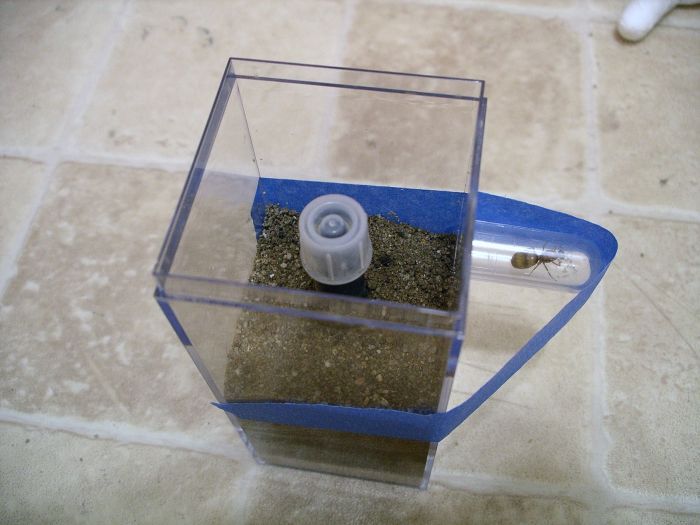
At first the queen ended up closing off the entrance of the tube with dirt, so I swapped the tube out with an even smaller one, but now she's sitting in that! She can barely fit in this tiny test tube, and she's choosing that as her nest over digging one in the dirt for now. I'll just keep waiting I guess. I figure she will eventually dig a nest when it gets too dry in that tube, but seeing how Myrmecocystus destroy their brood so much in test tubes, I'm afraid she will just sit in there until the eggs dry out.
I'll just keep waiting I guess. I figure she will eventually dig a nest when it gets too dry in that tube, but seeing how Myrmecocystus destroy their brood so much in test tubes, I'm afraid she will just sit in there until the eggs dry out.
I put four more of these in my little ant farm boxes. Getting their eggs to them was not easy. I failed with one of them and ended up destroying its nest, so I tried something different. I put another hole in the container like the bottom one at the surface of the dirt and taped a very short test tube to it with the eggs inside. I figure this will give her a place to keep the eggs until she is done digging her chamber. With smaller queens, I just give them their eggs, and they find a place to put them while they dig, but these queens are so large they will probably end up burying them.

At first the queen ended up closing off the entrance of the tube with dirt, so I swapped the tube out with an even smaller one, but now she's sitting in that! She can barely fit in this tiny test tube, and she's choosing that as her nest over digging one in the dirt for now.
#67
![Dspdrew's Myrmecocystus mexicanus Journal [124] (Updated 2-4-2024): post #67](https://www.formiculture.com/public/style_images/shivana/icon_share.png) Offline
-
Posted July 29 2015 - 7:53 AM
Offline
-
Posted July 29 2015 - 7:53 AM
Update 7-29-2015
A big storm went through the high desert on 7-19-2015, dropping well over an inch of rain in most areas in the Victor Valley. A few of us went out there two days later and found tons more of these queens. There were so many, we just had to stop collecting them. Again, the founding chambers were really easy to recognize due to their size in every aspect.
I put a bunch more of these in my small antfarm/dirt boxes. Some of the ones from Goffs already have quite a few medium sized larvae.
It's interesting watching how they dig their founding chambers. They like to dig all the way down, create a perfect little chamber, and then fill the hole all the way down to the chamber, completely sealing themselves in. So far these antfarm/dirt boxes seem to be working well for them.
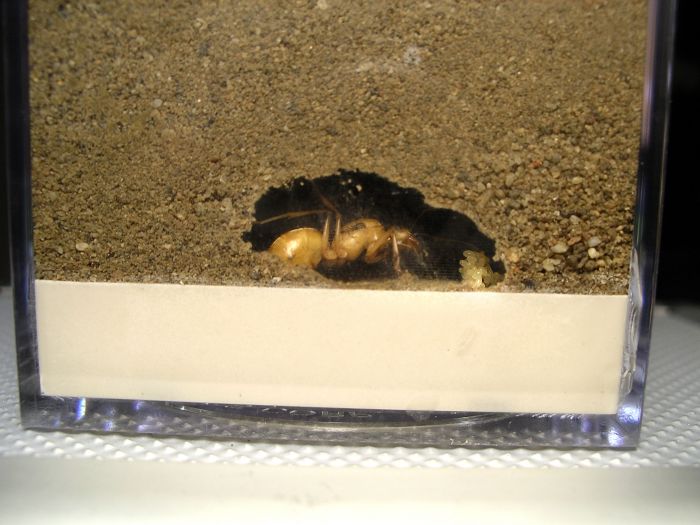
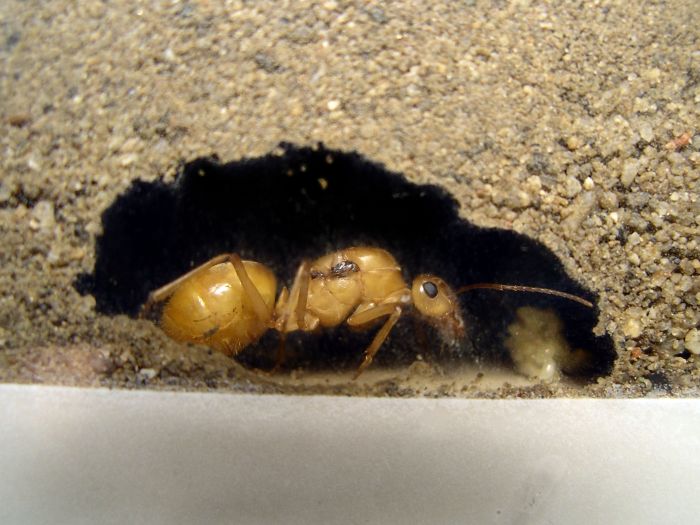
In this one you can see the queen's larvae on one side, and her pile of fresh eggs on the other.
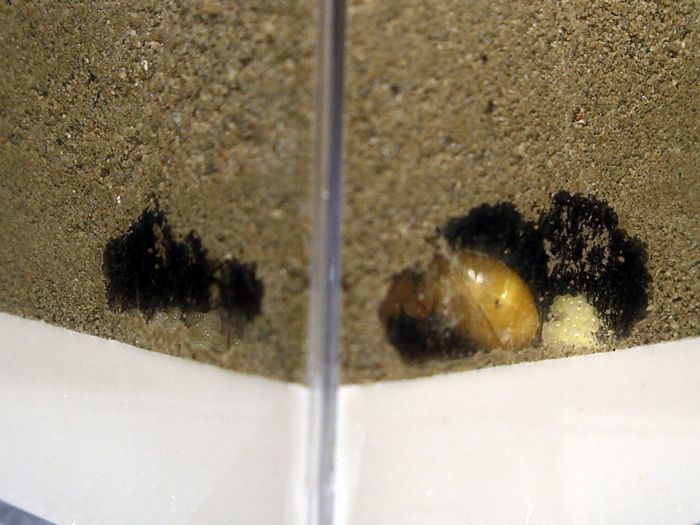

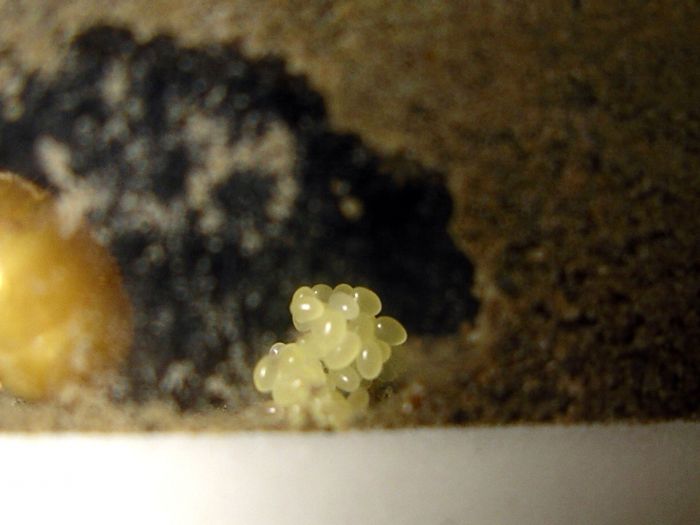
If you're wondering how attaching the tube went, the queen dug her nest and sealed it off, leaving all of her eggs just sitting in the tube... I no longer bother trying to give them their eggs, and instead donate them to other queens still in test tubes. If they're healthy, they should be able to lay plenty more.
A big storm went through the high desert on 7-19-2015, dropping well over an inch of rain in most areas in the Victor Valley. A few of us went out there two days later and found tons more of these queens. There were so many, we just had to stop collecting them. Again, the founding chambers were really easy to recognize due to their size in every aspect.
I put a bunch more of these in my small antfarm/dirt boxes. Some of the ones from Goffs already have quite a few medium sized larvae.
It's interesting watching how they dig their founding chambers. They like to dig all the way down, create a perfect little chamber, and then fill the hole all the way down to the chamber, completely sealing themselves in. So far these antfarm/dirt boxes seem to be working well for them.


In this one you can see the queen's larvae on one side, and her pile of fresh eggs on the other.



If you're wondering how attaching the tube went, the queen dug her nest and sealed it off, leaving all of her eggs just sitting in the tube... I no longer bother trying to give them their eggs, and instead donate them to other queens still in test tubes. If they're healthy, they should be able to lay plenty more.
- Foogoo, antmaniac, Wamdar and 3 others like this
#69
![Dspdrew's Myrmecocystus mexicanus Journal [124] (Updated 2-4-2024): post #69](https://www.formiculture.com/public/style_images/shivana/icon_share.png) Offline
-
Posted August 11 2015 - 9:01 AM
Offline
-
Posted August 11 2015 - 9:01 AM
Wow, It seems like you had good luck with this one.
Currently Keeping:
Trachymyrmex septentrionalis
Pheidole pilifera
Forelius sp. (Monogynous, bicolored) "Midwestern Forelius"
Crematogaster cerasi
Pheidole bicarinata
Aphaenogaster rudis
Camponotus chromaiodes
Formica sp. (microgena species)
Nylanderia cf. arenivega
#70
![Dspdrew's Myrmecocystus mexicanus Journal [124] (Updated 2-4-2024): post #70](https://www.formiculture.com/public/style_images/shivana/icon_share.png) Offline
-
Posted August 11 2015 - 9:05 AM
Offline
-
Posted August 11 2015 - 9:05 AM
#71
![Dspdrew's Myrmecocystus mexicanus Journal [124] (Updated 2-4-2024): post #71](https://www.formiculture.com/public/style_images/shivana/icon_share.png) Offline
-
Posted August 11 2015 - 9:07 AM
Offline
-
Posted August 11 2015 - 9:07 AM
Never think I would ever expect to see a Mexicanus with that much pupae.
Mine basically has the same brood count, just not as developed as they are kept in a cooler place. All of mine have 10-15 large larvae. I think all of us are going to get lucky this year with our catch of Myrmecocystus.
#72
![Dspdrew's Myrmecocystus mexicanus Journal [124] (Updated 2-4-2024): post #72](https://www.formiculture.com/public/style_images/shivana/icon_share.png) Offline
-
Posted August 11 2015 - 9:11 AM
Offline
-
Posted August 11 2015 - 9:11 AM
I have a few of them like this. The reason these are so much further along, is because I got them in Goffs, two weeks before everybody else got theirs in Phelan.
#73
![Dspdrew's Myrmecocystus mexicanus Journal [124] (Updated 2-4-2024): post #73](https://www.formiculture.com/public/style_images/shivana/icon_share.png) Offline
-
Posted August 11 2015 - 5:21 PM
Offline
-
Posted August 11 2015 - 5:21 PM
Have you had these reject boosted brood? One of mine died and left a nice pile of eggs which when I tried boosting to another queen, she dragged it to the entrance to let dry. I'm surprised she didn't at least eat them.
Camponotus vicinus, Crematogaster 1, Crematogaster 2, Formica francoeuri, *, *, Myrmecocystus testaceus, Novomessor cockerelli, Pheidole hyatti, Pogonomyrmex californicus, Pogonomyrmex rugosus, Solenopsis invicta
#74
![Dspdrew's Myrmecocystus mexicanus Journal [124] (Updated 2-4-2024): post #74](https://www.formiculture.com/public/style_images/shivana/icon_share.png) Offline
-
Posted August 11 2015 - 8:35 PM
Offline
-
Posted August 11 2015 - 8:35 PM
Sure. I've been moving their brood all over the place. Most every one I put in a dirt box, I had to do so without giving them their brood. All this extra brood I just give to one of the other queens.
#75
![Dspdrew's Myrmecocystus mexicanus Journal [124] (Updated 2-4-2024): post #75](https://www.formiculture.com/public/style_images/shivana/icon_share.png) Offline
-
Posted August 12 2015 - 7:33 AM
Offline
-
Posted August 12 2015 - 7:33 AM
Sure. I've been moving their brood all over the place. Most every one I put in a dirt box, I had to do so without giving them their brood. All this extra brood I just give to one of the other queens.
You mean you put them in the dirt box without their brood? Why is that? So sounds like it's just draw of the luck whether they'll take or reject another queens eggs?
Camponotus vicinus, Crematogaster 1, Crematogaster 2, Formica francoeuri, *, *, Myrmecocystus testaceus, Novomessor cockerelli, Pheidole hyatti, Pogonomyrmex californicus, Pogonomyrmex rugosus, Solenopsis invicta
#76
![Dspdrew's Myrmecocystus mexicanus Journal [124] (Updated 2-4-2024): post #76](https://www.formiculture.com/public/style_images/shivana/icon_share.png) Offline
-
Posted August 12 2015 - 10:29 AM
Offline
-
Posted August 12 2015 - 10:29 AM
Yeah. I've tried giving them their brood, but they usually just end up burying it on accident because of the limited space. They usually dig all the way to the bottom and around, so if they don't take too long, their brood will still be okay, and I can take out the plug and place it in their nest.
They almost always accept the other queen's brood.
#77
![Dspdrew's Myrmecocystus mexicanus Journal [124] (Updated 2-4-2024): post #77](https://www.formiculture.com/public/style_images/shivana/icon_share.png) Offline
-
Posted August 26 2015 - 5:41 AM
Offline
-
Posted August 26 2015 - 5:41 AM
Update 8-26-2015
By now I no longer have any of these in plain test tubes. I had about half of them in dirt boxes, and the other half in small foraging containers. Some of these containers are setup to only use the test tube for hydration. In those containers, the test tube keeps the substrate moist at all times. The colonies this time around are doing way better than I've had any honeypot ants do before.
Here is one that kind of built a little wall around the area it considers its nest.
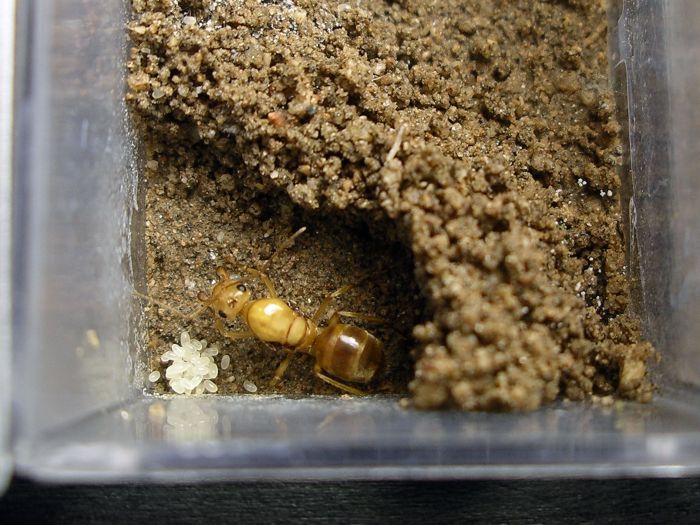
A few of the colonies from Goffs had their first workers eclose a week ago. A couple days ago, a few of them opened up their nest for the first time and filled up on hummingbird nectar. Unfortunately, last night I found four of the queens housed in the dirt boxes dead. A couple of these had a large amount of brood just days from eclosing too. I was able to retrieve the brood and donate it to a few of the other queens. I gave it to the only two left in dirt boxes with workers and open nests. It didn't take long for the workers to take it all down into their nests. I have no idea why queens that seemed to be doing so well just died like that all of a sudden, but that is exactly why I collect so many from the start.
I'm expecting the colonies from Phelan to all be getting their workers soon, so when that happens I'll have another update with plenty pictures.
By now I no longer have any of these in plain test tubes. I had about half of them in dirt boxes, and the other half in small foraging containers. Some of these containers are setup to only use the test tube for hydration. In those containers, the test tube keeps the substrate moist at all times. The colonies this time around are doing way better than I've had any honeypot ants do before.
Here is one that kind of built a little wall around the area it considers its nest.

A few of the colonies from Goffs had their first workers eclose a week ago. A couple days ago, a few of them opened up their nest for the first time and filled up on hummingbird nectar. Unfortunately, last night I found four of the queens housed in the dirt boxes dead. A couple of these had a large amount of brood just days from eclosing too. I was able to retrieve the brood and donate it to a few of the other queens. I gave it to the only two left in dirt boxes with workers and open nests. It didn't take long for the workers to take it all down into their nests. I have no idea why queens that seemed to be doing so well just died like that all of a sudden, but that is exactly why I collect so many from the start.
I'm expecting the colonies from Phelan to all be getting their workers soon, so when that happens I'll have another update with plenty pictures.
- Alexant and antnest8 like this
#78
![Dspdrew's Myrmecocystus mexicanus Journal [124] (Updated 2-4-2024): post #78](https://www.formiculture.com/public/style_images/shivana/icon_share.png) Offline
-
Posted August 29 2015 - 4:46 PM
Offline
-
Posted August 29 2015 - 4:46 PM
.
Edited by Here for the honeypots, December 6 2015 - 10:57 PM.
#79
![Dspdrew's Myrmecocystus mexicanus Journal [124] (Updated 2-4-2024): post #79](https://www.formiculture.com/public/style_images/shivana/icon_share.png) Offline
-
Posted August 29 2015 - 4:47 PM
Offline
-
Posted August 29 2015 - 4:47 PM
Or when you get a queen. Thanks!
#80
![Dspdrew's Myrmecocystus mexicanus Journal [124] (Updated 2-4-2024): post #80](https://www.formiculture.com/public/style_images/shivana/icon_share.png) Offline
-
Posted August 29 2015 - 4:56 PM
Offline
-
Posted August 29 2015 - 4:56 PM
Or just when you get a new queen. Thanks!
Also tagged with one or more of these keywords: myrmecocystus, dspdrew, journal
1 user(s) are reading this topic
0 members, 1 guests, 0 anonymous users







